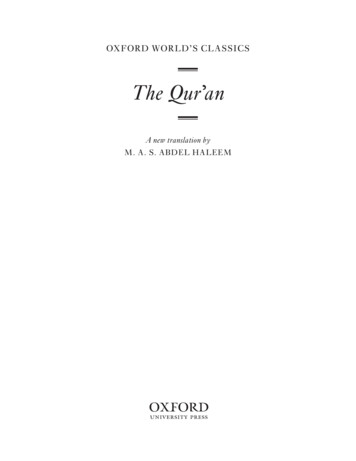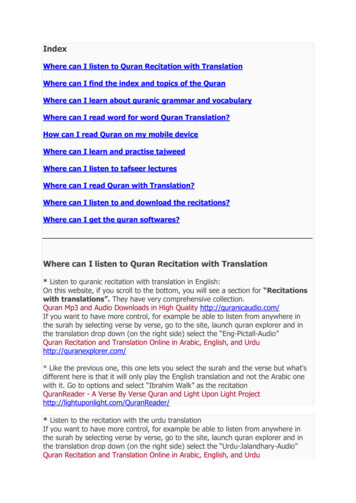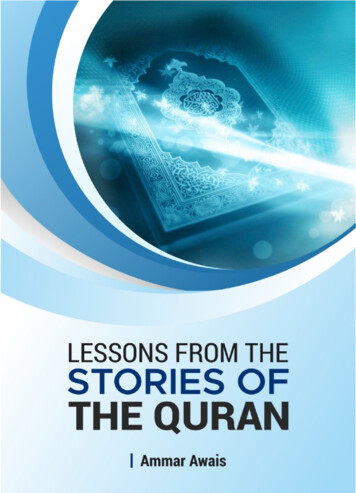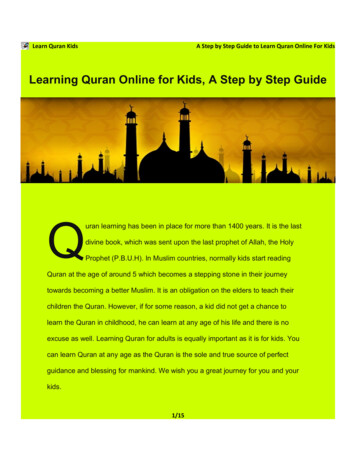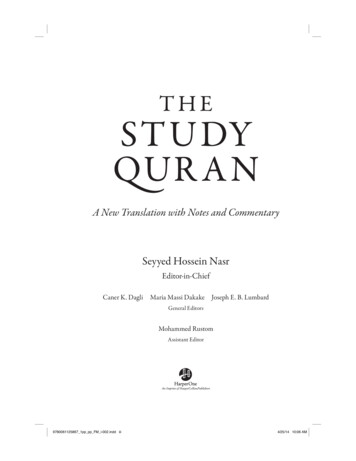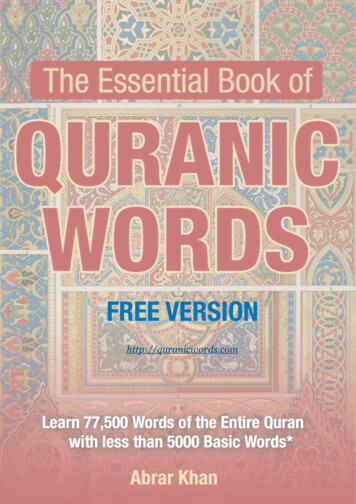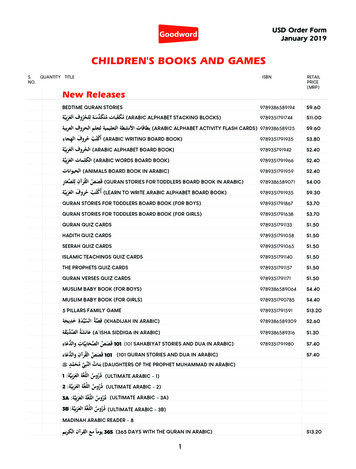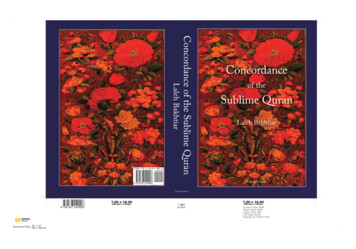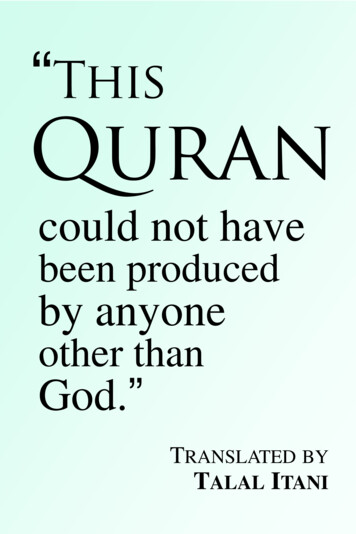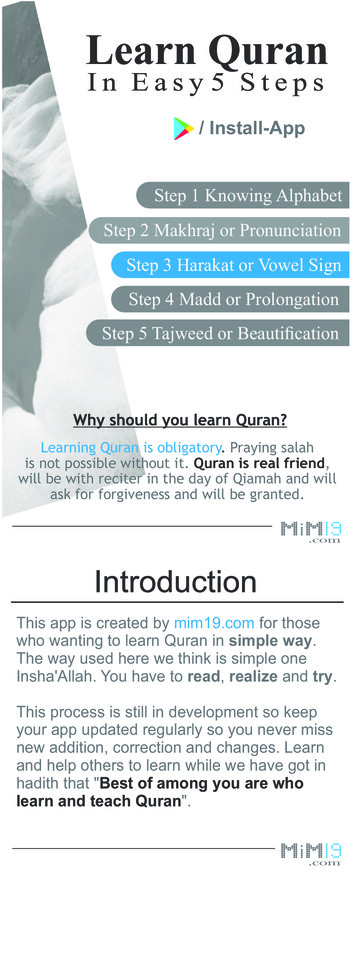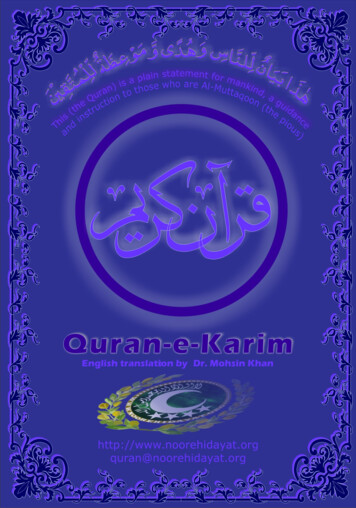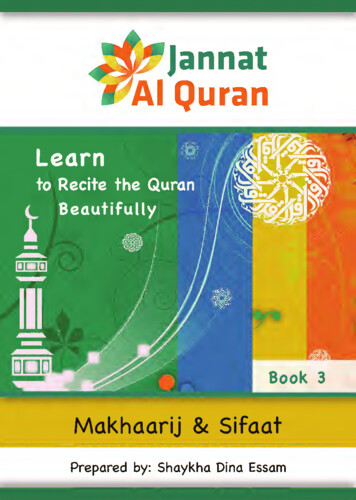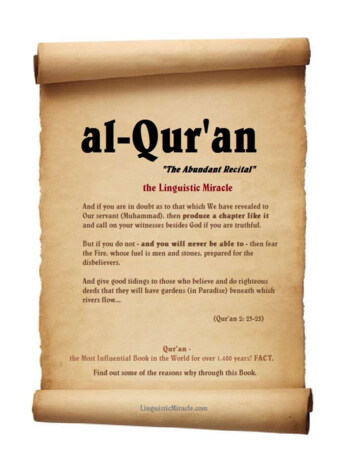
Transcription
1
QUR’AN - the LINGUISTIC MIRACLE BOOKContentsSection 1: The Arabic LanguageChapter 1: Introduction to the Arabic Language (Why it’s Unique): . 4Chapter 2: Etymology of Arabic (Base Letters & their meanings) . 7Chapter 3: Grammar vs Phonetic Languages, and Arabic (Letter Sounds & Shapes): . 15Chapter 4: Richness of 3 Letter Arabic Vocabulary (Rich Meanings): . 28Chapter 5: Words longer than 3 Root Letters (Fusing words) . 35Chapter 6: Synonyms and Antonyms: (Words are known by their ‘Relatives’) . 38Chapter 7 - Classical Arabic Poetry: . 41The Generous man & the Mu’allaqah of ‘Amr bin Kulthum . 41Palindromes (spelling something the same in reverse): . 44Chapter 8: Balaaghah & Eloquence (Subtle meanings) . 45Past tense (maaDiy) vs Present-Future tense (muDaari’): . 45Noun (constant) vs Verb (temporary):. 46Female Plural used for non-Female objects ‘Handful’ (less than 10) . 47Chapter 9: What is the ‘Perfect Language’? . 49Section 2: The Qur’an . 52Chapter 10: Introduction: . 52Chapter 11: Qur’an Gems . 56Chapter 12: Sounds [Onomatopoeia] in al-Qur’an. . 57Chapter 13: Qur’an Gems: Precise Word Choice, Word-Play, Palindromes, Imagery, &Movie-Epic scenes! . 61Your Life Summarised in 1 Aayah/verse! . 62Quranic Palindromes. 63Precise Word Sequencing . 71Replace the word Sky with Man, and Earth with Woman. . 72Repose, Affection & Mercy . 63“ Her heart became empty ” . 74And Jaheem [Hell] will be Pulled out for those to See . 75His mother is Hell, the War Horse & Description of Paradise. . 76Chapter 14: How to Extract Quran Gems . .88Step 1 - Focus on Words and their Power: . 88Step 2 - Sentence structure - Placements of words in an Ayah - p84 . 95Step 3 - The Location of an Ayah within a Passage of Discussion . 86Step 4 - See how all the Passages Connect to work Together to produce 'Themes' . 88Step 5: Produce an overall Conclusion 892
Section 4:- ScienceChapter 15: Scientific Marvels in the Qur’an . 100How do Arabic Definitions work? . 101Scientific Miracle 1 - Sulaalah:. 104Definitions: . 104Nutfah: . 107Two meanings of Nutfah combined: . 109Amshaaj: . 109Maniy . 1101st General Meaning:. 1102nd Meaning: . 1103rd Meaning: . 1114th meaning: . 111Relation to Modern Science: . 112Even More Amazing! : . 113Male’s Sperm Determines Gender of Child: . 113Alaq . 114Summarised: . 115Section 5: Qur’an Challenge . 118Chapter 16: Unique Qur’an Structure. 119Chapter 17: Understanding the Qur’an Literary Challenge: “Bring Something Like It” . 121Chapter 18: Responses to the Qur’an Literary Challenge: Musaylamah. 124‘Surah’ Iman [Faith]:. 126Our Refutation: . 1301 – Incorrect Plagiarism of: . 1302 – Incorrect Useage of: Reeh & Riyah – Wind. . 1313 – Use of Comical Expressions:. 1334 – Lack of Smoothness/Flow in Recitation: . 1335 – Unnecessary Words – could easily be Removed – without altering it’s Meaning. . 133Words/Phrases which could be Summarized: . 1346 – The Story itself has a Lack of Thematic Connection & Meaning: . 134The Beginning Verse, & the Last Verse were Plagiarised from the Qur’an Purposelly . 138Section 6: What Experts & Orientalists said about the Qur’an Language: . 139Section 7: Meaningful Prayer . 146Section 8: Miscellaneous: Further Reading Dictionaries Websites Contact3
Introduction to the Arabic Language:The Arabic language is a unique language, and has many special and unique features whichmake it suitable for it to convey; many meanings in few words, subtleties, emphasis andpowerful imagery through speech alone. If God was to convey a message to mankind, it wouldbe through a language which is easy to learn, and has the highest form of expressiveness. Ibelieve that Arabic is that language by which He communicated His final Message to mankind,and I will try to prove it through this Book – Qur’an, the Linguistic Miracle.In the first section of this Book, I will be introducing Classical Arabic (a more in-depth version ofthe language in comparison to the Modern Fus-ha Standard, Spoken Arabic aka MSA). I willexplain the literary tools of Classical Arabic, with examples, and later near the end of thissection, I will share a few gems of Classical Arabic language, to give you a feel of how theClassical Arabs expressed themselves through Poetry, and what powerful literary tools theyused to convey their message to an equally praiseworthy literary audience.What is the Arabic language?Arabic is an ancient Semitic language, believed to be over 2000 years old. So it has had alot oftime to develop, and enrich its meanings and linguistic beauty. Some say it – the language- hasbeen inspired and preserved miraculously in its pure form. It has stayed firm and pure to itsroots, meaning that words and their meanings which were said over 1,400 years ago are stillpreserved and documented for us uptill this day. Unlike many other languages where wordschange meanings every few generations, and the meaning of the original word is lost. Anexample in the English language today is the word 'wicked' which meant 'evil' last generation,but in this generation it means 'good.' It may be that 2 generations ahead, 'wicked' may only berecognized as meaning 'good', possibly making future readers of the language confused.How is Arabic Structured?Arabic works with a triliteral root system, which means that most words are made of 3 RootConsonant letters, and other 1 and 2 letter words with different meanings surrounding thatword. It is then for the reader to use his knowledge of the language to separate and distinguishbetween the letters to understand which letter means what.This will be explained later in the book, and is a fun part of learning the language. (Almost likeconnecting a jigsaw puzzle.)4
How does Arabic language work?Arabic 3 Consonant lettered words are usually 'Descriptions'. These Descriptions will then fitinto Contexts for Objects.For example; the word 'sayyaarah' means 'Car'. But in reality, it comes from the root meaningof the 3 Root Letters: Siin-Ya-Ra (s-y-r) Meaning: 'Travelling through Movement.'We therefore see that other words like i.e. 'he went for a walk' (saara), or "siiyrah" (a walkthrough a journey), which have similar Root letters have similar meanings, simply due to theirRoot letters being the same. This makes it extremely easy to know what a word means inArabic, because you might see a long difficult word, but you break it down to look at its root 3letters - and voila! You know what root meaning and description is being hinted at. This allowsyou to visualize the picture being portrayed through the Arabic.This root system is also found partially in other languages, but Arabic sustains this rulethroughout its entire language consistently, which makes its richness even more exciting toexplore.What makes it even more exciting is that the Arabic language has one of the richest sets ofVocabularies in the world, probably more than any other language. (For example: the Arabshave over 1000 words just for describing the Camel, and over 60 different words for Love!) Andthe amazing bit is - every word has its own shade of meaning, so two words could be similar,but they both would have a slightly different implication in meaning.Arabic has no unnecessary words in it:Arabic is extremely concise i.e. A sentence of 7 words in English can be said in just 7 letters ofArabic!Example;English: 'Both are at war with each other.'Arabic: yu-Haarib-oon. [pattern 6 on the Arabic verbs scale.](Note: vowels are not included as 'letters' in Arabic language since they can be omitted and the word is stillreadable.)See how concise Arabic is?5
Arabic is a language which is directly to the point, and removes all unnecessary words from asentence, so that only the necessary words remain for the sentence to be conveyed, spokenand understood quickly. The example above proves this well.What have we Learnt in this section?1 - Arabic language is based on a Triliteral (3) Root letter system.2 - Each Noun (Object) is infact a 3 letter 'Describing word', and if an Object matches a certainDescription, the Object is called by that Descriptive word. I.e. Sayyaarah means [Description:]'that which always Travels' ( Car [Noun]).3 - We have learnt that the Arabic language is Pure to its Roots, and words can be traced backto their Origins from over 1,400years ago through Lexicons.4 - We have learnt that Arabic is one of, or the biggest Vocabulary filled language in the world.5 – Arabic is directly to the point and a concise language, conveying long sentences fromanother language into just a few words of Arabic.6
Etymology of ArabicWhat each Letter Etymologically means?Etymology (Ishtiqaaq) of Etymology:If you've studied how words in a language originated, you have probably come acrossEtymology. Etymology allows us look into the history of words and their origins to get a fullerand more pure understanding of a word. For example in modern English, the word; 'texting' canbe broken down into two words; text (meaning 'writing'), and 'ing' (a suffix meaning; 'to do').Text-ing therefore 'to do writing.'This mixing of words is common in all languages, and this is how vocabulary increases overtime. But not surprisingly, Arabic goes a step further.Why is Arabic special in regard to Etymology?We know already that Arabic has short 3 letter words, each word covers a huge range ofdescriptive and visual meanings (and will be explained further with examples in a later chapter).This 3 letter words system is special to the Arabic language, and although this triliteral rootsystem is also present in some other languages, the Arabic language goes one step further - the3 root letters of a word can be further broken apart one by one to gain even moreunderstanding of how even that 3 letter word was made.I have produced a table (see next page) with examples later on, wherein each letter of theArabic alphabet has a meaning assigned to it. A big jazaak Allahu khayran (may God reward you)brother Mansour for producing this amazing research.Note: The meanings on this etymology table may not directly mean what they are spoken to mean in full speech.The reason for this is is clear; etymology works on base letters and their base meanings, and requires someknowledge of Sarf (Arabic morphology), aswell as reflection on similar words and sometimes deeper research.Etymology Table:7
Arabic Letter ا Alif ب ba ت ta ث tha ج Jim ح Ha خ Kha د Dal ذ Dhal ر Ra ز Za* *س Sin ش Meaning-First-Reference-Manifest itself-Medium-BringExamplesAllah.-Time-Following / nJam3a Join/gather, Jumlah(sentence),Jawaab (response joins tooriginal saying),Jund (army together)etc.).-Life-Benefit-LiveHayaat Life-Creation-Composition /Decomposition-CreateKhalq creation-Direction-Tend towardsThe word: dal direct-Carrying a Separation-Slice-In progress-Support-Energy Flowing-Radiance-DiffusionShams (sun) spreading rays,8
Shin-SpreadShajarah (tree)spreading branches etc.] ص -Homogeneity (i.-Consistent-Full (i.e. a Solid Block)SiraaT a Full straight Path.Sad ض Dad ط Ta ظ Zal* ع 3aïn* غ Ghaïn* *ف Fa ق Qaf ك Kaf* *ل *Lam*-Lower plan-PropertiesEarthEstablishSurfaceAxisTareeqah a PathAppearanceExtendŒilPerceptionSee‘Ayn the Eye (or anythingwhich is pleasing to the eye)VeilGhayb UnseenGhafr to CoverGhulf a Wrapping.CoverInsideBreathInsertFam MouthConscienceExistenceStandSimilarityOther like me, LikenessQiyaam Standing.ServiceForProvide9
* *م Mim* *ن Nun هاـ *Ha* و Waw ي YaPlaceThingBeingUsGenericUniteHimThe retract (invisible)SouvenirAdd RIGINS-2.pngHow do I use the table?Simply think of a word, and break it down into individual letters, and then find the meaning ofthat letter from the table. Add the meanings together, and you will see the deeper makeupmeaning of that word.I have some examples which may give you an idea of how this works;If we see the 3 letter word S-H-bLetter: Sad (meaning Consistent [constant]), Haa Life, Baa medium. SuHbSo what is a; '[S-H-b] Constant Life Medium'? It is a Companion (SaaHib) who you always(constantly) turn to for Mediation in Life.If we look at the letters; Haa (Life) Ba (Medium) "H-B" a Life Medium. The word 'HuB' means'Love' in Arabic, so someone you Love is your 'Life Medium' (an intermediate (middle/medium)person who you always turn to to share lifes joys and sadness).10
The word 'Hib' also means a 'Gift' - which is a 'Life medium' between two people to gain a(lovable) connection between each other.'Hab' is also a seed or grain, because it is a 'life medium' for people to survive off because theyeat it to live.One could go further by looking at Sad Haa SaH (meaning 'correct') because letter Sad Constant Haa Life 'Constant Life' (that which is Correct is 'Constantly Living' ('Truthprevails.)I will produce more examples which you can refer to.Example #2:3a-Q-L 3ayn (See) - Qaf (Maintaining) - Lam (For) See, to Maintain, For.Meaning: You 'See' (an event) and you 'Maintain' its lesson in your mind 'For' your future, i.e.So you don't fall into similar mistakes in the future.[Example #3: ( ‘ ) ﻞﻘﻋ AQL the Intellect which helps you to ‘Restrain‘ yourself from wrong/stupid things. Letter 3ayn ( )ع to See. Qaf ( ) ق Maintain. Lam ( ‘ )ل For’ This makes sensebecause a person ‘Sees‘ some things, and uses his Seeing to‘Maintain‘ his mind ‘For‘ preventinghimself from doing stupid things in the future of his life. ( ‘ ) ﻞﻘﻋ AQL – the Intellect.]Example #3:3i-L-m (3Ayn, Lam, Miim) means 'Knowledge' but broken down it means; Seeing[ayn]For[laam]-Being[baa].i.e. You 'see' something 'for' you to 'Be':- better, more knowledgable, more experienced etc.Example #4:S-L-M Siin Provide help/support/energyLam ForMiim (a) Being (i.e. a human, or God) etc.11
Example #5:The word: Khalq ( )ﻖﻠﺧ Creation. If we break the word down, it is made of3 letters: Khaa, Laam,and Qaf. ( ) خ Khaa Create/Compound ( )ل Laam For ( ) ق Qaf Maintain/Erect/Uprightness/Standing. ( )ﻖﻠﺧ Kha-L-Q Created For Maintaining/Standing.Example #6:Shams Sun.Shiin spread/dispersemiim - being/thingsiin - energy flow(the Sun is a thing which disperses and spreads its energy.)Example #7:shajarah treeshiin - spread/dispersejiim - assembly/joinra - orderSomething which 'assembles and joins together' in an 'order' while being 'spread out anddispersed' a tree.Example #8:Dad Earthra order / commandba medium/bringDarb 'to Hit'.Etymologically, we know the Arabs referred to 'striking the Earth' (Darb) when referring totravelling in the Earth.12
So Darb etymologically refers to the striking the Earth [Dad] in a certain Order [Ra] (step bystep), as a Medium [Ba] to Travel and earn a living (i.e. travelling in the Earth for business etc.)Example #9:NuShr to Disperse (i.e. the picture portrayed is of someone throwing/dispersing seeds indifferent directions.)Nun UnifiedShiin Disperse / SpreadRa Order someone who has something altogether in his possession (Unified, i.e. a handful of seeds), hethen Disperses them by throwing them in a certain Order (i.e. dispersing them from right toleft).Example #10:Dhahr the ‘back’, and it also refers to ‘strength’ (of others supporting you). Its etymologicalmeaning might be explain why better;Dha Extendha himRa Order/Command someone who is your Dhahr is your back, your strength. They are extending your strength(just as your back physically supports you, and your supporters help extend your strength formore Order and Command in your life.)What if I can’t find the Etymological Meaning?This table is best experienced with comparing already created words, knowing their definitions,and trying to find out why those base letters were used to construct that meaning (i.e. Similarto ‘Reverse Engineering’.)Hints could be found by looking at other words which begin with that same Root Consonantletter.Tayyib Pure.The 'Ta' Axis.13
How is that related to purity, you don't know? Okay then look for another word starting with'Ta'. Tabeeb is a Doctor/curer. The curer/doctor will fix someone back to their normallyadjusted self (a set Axis.)So Tayyib starts with 'Ta' and may have some relation to being in accordance with the Axis, thedefault state of the Human.We know Tayyib is that which is 'Pure' in accordance with the bodies default (axis) state.Humans love purity. So Tayyib pure and good, that which the body is adjusted to and likes foritself.This does seem quite tricky and requires alot of deep thought and 'primary base level thinking'.But those who created the language (or if it was truly divinely inspired as a whole) - were alsoof a great intellectual understanding to produce such a deeply pure language - from its rootsupwards.I hope these examples will suffice, and you can practice with more if you wish.How is this system Unique to the Arabic language?Although a small amount of languages have a triliteral word root system, and an even smalleramount can break down each of the words into 1 letter etymological definitions, Arabic hasuniquely remained consistent to its original etymological roots. The other languages have hadchanges to their words later in history (due to a lack of preservation of words and their classicaland original meanings). And this is why one can accurately use the table for the Classical Arabiclanguage words and their original classical meanings, but will find difficulty relating theetymological roots to present day words in other languages.14
Etymology 2 Sounds - Arabic 1 letter Sounds:Grammar vs Phonetic Languages, and Arabic:If you have studied world languages, you will know that languages heavily lean into either ofthese 2 categories; Grammar based or Phonetic (sound) based.Usually the language may start off with both concepts in mind, but only one of these will begiven priority more than the other, and the language will then focus on that aspect more for itsArt and beauty (this is usually because of dialects (off-shoots of the language) distorting theoriginal Language's grammar rules).Grammar Based Example: the English language grammarians worked hard to make a set ofconstant grammar rules which the language would abide by. [example: the suffix 'ing' means'to' i.e. Runn-'ing' 'to' Run] (However sadly, they could not continue this implementation ofgrammar rules due to a constantly huge influx of words being imported to England from foreignlanguages.) But what we learn is that although there was a heavy focus on grammar in theEnglish language, the language was lacking in the Phonetic sphere. So there was not muchpoetry which 'sounded' amazing, because there was never really a strong focus on making thelanguage 'sound' effective or inspiring to the ears in the first place.Phonetic Based Example: The Punjabi language is spoken in South Asia, especially in Pakistanand India. This language has a strong Phonetic (Sound) influence and is powerful in conveying amessage orally. Infact, this language is so dependant on its Phoneticness, that if you do not saya sentence in the right 'tune', it could mean the total opposite.[Example: "Tu jana Ni(?)" You're NOT going(?) - this phrase would be a Question (?) if youended the phrase in a high pitch, and it is a Command if you end it in a low pitch voice.]Now although this Phonetic language style is interesting, the grammar side of the language isreally weak. The example given is a proof of this.How is Arabic different?Unlike many other languages, Arabic stays balanced and consistent when approachingGrammar, AND Phonetic sounds. It contains both.15
Arabic - Grammatical & Phonetic:We have discussed earlier how Arabic has used specific letters and words consistently forcertain specific meanings. This is one example of Arabic sticking firmly to its grammatical rules.But Arabic doesn't stop there. While maintaining its Grammar, it also has heavy focus onPhonetics (sounds of the language.)How does it do this?There are many unique ways Arabic has achieved phonetic power. I will explain some now, andothers will be explained later God willing.We know the Arabs have a rich alphabet, with many letters sounding similar to each other. Onehas to study the art of Advanced Tajweed (recital) to appreciate the differences between thedifferent letters. But this section will give you a glimpse to appreciate the differences in similarsounding letters.I will try to provide examples and comparisons in a table to illustrate this.Method:i - Look at similar sounding audible letters?ii - compare the differences in sound.iii- Then look for words which contain that sound in the same place/location in the other word.(i.e. If one word has a letter Kaf as a 1st word root letter, then the compared word should alsohave the similar sounding letter as the 1st word root letter.)iv - compare their meanings.v - make a conclusion why you think one word has a more slightly different sound than theother word.I.e.i - Kaf and Qaf.ii - Kaf is lighter in pronunciation compared to Qaf which is heavy sounding.iii - Kalaam and Qalamiv - Kalaam (speech) and Qalam (pen)v - Kalaam (speech) sounds lighter in pronunciation than Qalam (Pen) because Speech is lessheavier than a Pen when it comes to i.e. Preservation of information. So a Pen is more heavierin the sight of the Arabs than speech.Arabic Letters Sounds Table:16
SimilarSoundingLettersKaf ( ) ك Comparing TwoSimilar WordsDifferences inSoundComparison inMeaningConclusionKalaam ( ) كالم (Speech)Kaf is lighter inpronunciationcompared toQaf which isheavy soundingKalaam (speech)sounds lighter inpronunciation thanQalam (Pen)Haa sounds likebreathing on awindow fromyour throat.Kha soundsslightly harsher(like takingmucus out ofyour throat).Kh sounds like abite intosomething softand juicy.NaD-H ( ) نضح (water Flowing)Speech (kalaam)is less heavierthan a Pen(Qalam) when itcomes to i.e.Preservation ofinformation. So aPen is heavier inthe sight of theArabs thanspeech.Flowing Water issofter in soundcompared toGushing water. Soa harsher letter(Kha) has beenused for Gushing.A smoother one(Ha) for ‘Flowing’Qaf ( ) ق Qalam ( ) قلم (Pen)Haa ( ) ح NaD-H ( ) نضح Kha ( ) خ NaD-Kh ( ) نضخ Kha ( – ) خ softKhaDam ( ) خضم Qaf ( – ) ق hard /toughQaDam ( ) قدم Qaf soundsheavy, tough.Siinsa’ida ( ) سعد SaadSa’ida ( ) صعد Siin sounds lightand pronouncedwith an emptymouth.Saad soundsheavy andpronouncedwith a fullmouth.NaD-Kh ( ) نضخ (water Gushing)[see Qur’an 55:56]KhaDam ( ) خضم bite into somethingjuicy.Kha fits the roleof biting into ‘softand juiciness’QaDam ( ) قدم biteinto somethinghard (i.e. a Nut).Qaf as a heavyand tough letterfits biting intosomething tough.Siin ispronouncedlighter than Saad,so the lighterletter is used toportray internalrising, and theheavier letter isused to portrayphysical rising.sa’ida ( ) سعد Risinginternally. (i.e.being happy)Sa’ida ( ) صعد Rising Physically.(i.e. climbingmountain)17
dhaldhall ( ) ذل to Humble.dhaluwl ( ) ذلول Humbleness.Submissiveness.dhal is a weakand soft letter.Sohere it representshumblenessinternally.Zaa is a strongletter. So itrepresentsphysicalHumiliation(slipping).ZaaZall ( ) زل to Slip.Zalzala Repeatedslipping (in aearthquake)Zaa‘Azm ( ) َعزم Dhaa‘ADhm ( ) َعظم Zaa is a sharp‘zed’ sound.‘Dha’ is to say‘za’ with a fullmouth.‘Azm Firmness in Although ‘zaa’ isintention/willpower a sharp sound, itand inner strength. focuses more onthe ‘inner’'ADhm somethingstrengthwhich is Physically compared to theFirm, i.e. the Bonethe fullis called ‘ADhmmouthed ‘Dhaa’which focuseson outerstrength.What you can learn from this Table:Next time you hear two similar sounding words, ask yourself how and why they sound differentand by what vocal means (makhaarij). You will then be able to figure out their difference, andthis skill will be extremely valuable to you since some morphed words are not mentioned in thedictionaries.A big jazaak Allahu khayran (may God reward you) Mohtanick Jameel for producing these examples inyour videos on youtube (ArabicLikeABoss)18
Quality in Letters vs. Quality in MeaningThe letters of the Arabic alphabet have several associated qualities such as being light or heavy,being easy to pronounce or being difficult, and so forth. Most of the qualities have been listedbelow.LettersPronounced شﺧص فحثه سكت Pronouncedweakly and witha flowing breathFaHaThaShiinhaSound ProducedCompared toother Letters inthe AlphabetW Whereas the otherletters arepronounced withmore vigour anddo not flow aswellShiinKhaSadSiinkafta بكت قط أجد Alif-hamzaJiimdalpronounced,while the otherletters are softerthe other lettersare softerQafTaabakafta19
قظ ضغط ﺧص KhaSadthe heaviestletters of thelanguage; theyare heavy, fat,thick, full-mouthletters,the other lettersare not asintensewhile the otherletters are not asintenseDadGhaynTaQafDha ظ ، ط ، ض ، ص SadDadTaDha فر من لب FaRaMiimNunLamBafull letters andthe tongue risesto the top of themouth andembraces thepalate duringtheirpronunciationare articulatedvery easily,quickly, swiftly,and with minimaleffortthe other lettersare not quite aseasilypronounced قطب جد QafTaBaJiimdal ص ، س ، ز zaasiinSadwhen withoutvowels, will b
Arabic is extremely concise i.e. A sentence of 7 words in English can be said in just 7 letters of Arabic! Example; English: 'Both are at war with each other.' Arabic: yu-Haarib-oon. [pattern 6 on the Arabic verbs scale.] (Note: vowels are not included as 'letters' in Arabic language s
